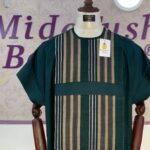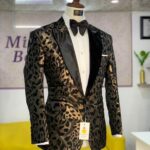
In the 1960s, the dashiki appeared in the American ethnic fashion inventory along with other Afrocentric clothing styles embraced by the black pride and white counterculture movements.
A unisex garment which is loose-fitting and sewn from colourful African-inspired cotton prints or solid colour fabrics, often with patch pockets and embroidery at the neckline. In the celebration of identity through fashion, this symbolic garment has become the trendiest casual/street wear for people of African descent worldwide and is now enjoyed by a much wider audience than ever before and, this being the case, it’s been recreated into visually attractive and sophisticated designs. A classic example is Midetush Bespoke’s made-to-wear two-piece unisex Dashiki set.
This made-to-wear two-piece set is a fusion of wool and ‘aso-oke’ (meaning top-cloth); a hand-woven cotton fabric which originates from the Yoruba people of Nigeria.
The inspiration of the design, coined from embracing the African ancestry with an infusion of urban contemporary style. The neckline constructed with a concealed zipper running through the left shoulder of the dashiki is a striking proof of creative ingenuity.
The ‘aso-oke’ fabric stitched widely around the chest region and below the belly region, against the wool fabric leaving a partitioned gap is executed with attention to detail. The trouser is tapered around the waistband with elastic and a piece of rope inside-out ensuring a proper fit.
Although, the fabric strands evident at the base of the dashiki creates an informal variant of retro appearance, it would have been a better look if it were a bit shorter and thicker. This piece is a timeless wardrobe investment and a statement of cultural diversity symbolising affirmation and a return to the African roots. A unisex clothing designed to celebrate African history and the beauty of Black heritage.













